In an era marked by rapid technological progress, the integration of multispectral cameras with drones has brought about a new dimension in image capture and analysis. With the increasing demand and significance of multispectral cameras for drones, we look at how these cameras work, their applications and the best drones with multispectral cameras.
What Are Multispectral Cameras?
Multispectral cameras are advanced imaging systems that capture image data within specific wavelength ranges across the electromagnetic spectrum.
Unlike the human eye, which sees colour in three bands (red, green, and blue), multispectral cameras can capture data in multiple bands, including those beyond the visible spectrum, like ultraviolet and infrared. By enabling us to see what the naked eye can’t; multispectral cameras allow us to observe a vast range of data from different parts of the electromagnetic spectrum, including ultraviolet and infrared wavelengths, thus providing a richer, deeper understanding of the world around us, its composition, and hidden patterns.
These insights can be utilised in industries like agriculture and forestry management, where they help monitor crop health, forest density, allowing for early detection of disease or pest infestations and enabling more sustainable management of resources.
In environmental science and conservation, they facilitate the study of plant and animal populations and changes in ecosystems over time. Moreover, in the field of archaeology, they help uncover buried structures and artefacts, revealing insights into our historical and cultural past that may have otherwise remained hidden.
When we consider the best drones with multispectral cameras, we’re looking at an incredibly powerful combination. When commercial drones are equipped with multispectral cameras, they offer the capacity to gather high-resolution, detailed image data from vantage points that were once challenging or impossible to reach.
This combination has considerably expanded the potential applications of multispectral imaging, offering high-speed and efficient data collection over extensive areas.
In today’s fast-evolving digital landscape, multispectral cameras for drones have become instrumental in transforming sectors like agriculture, environmental science, infrastructure inspection, and disaster management.
This article will delve into the captivating realm of drone-based multispectral imaging, illuminating its workings, applications, and the compelling advantages of choosing the best drones with multispectral cameras.
Applications Of Multispectral Cameras For Drones
1. Precision Agriculture
In agriculture, drones armed with multispectral cameras have revolutionised crop health monitoring and irrigation management. They enable the capture of detailed images that can help identify areas of stress in crops due to disease, pest infestation, water shortage, or nutrient deficiency. This technology, often referred to as precision agriculture, allows farmers to target their interventions, leading to increased yield and cost-effectiveness. Moreover, multispectral cameras can help monitor irrigation systems and identify areas where water distribution is uneven, thereby conserving water and ensuring optimal crop growth.
2. Environmental Management
In the field of environmental science, multispectral cameras mounted on drones are used to track deforestation and study wetlands. They can detect changes in vegetation and soil health over time, providing crucial data to researchers. In wetland studies, these cameras can help differentiate between various types of vegetation and monitor changes in water levels, contributing to better management and conservation strategies.
3. Infrastructure Inspection & Monitoring
The infrastructure sector has also benefited from drone-based multispectral imaging. Building and construction inspections that once required intensive manual labour can now be done quickly and safely. Drones can access areas that are hard to reach or potentially dangerous for humans, like high rooftops or unstable structures. Similarly, in pipeline monitoring, drones can cover vast distances quickly, identifying potential leaks or weaknesses with high precision.
4. Archaeology
In archaeology, multispectral drone cameras are used for site discovery and analysis. These cameras can reveal details invisible to the naked eye, such as soil discolourations indicating buried structures or artefacts. This technology allows for non-invasive examination of archaeological sites, preserving their integrity while gathering valuable data.
5. Disaster Management
Drones equipped with multispectral cameras play a crucial role in disaster management. They can quickly assess damage after a natural disaster, providing real-time data to emergency responders. This enables a swift response, potentially saving lives and speeding up recovery efforts.
Why Drones Are Better For Capturing Aerial Data
Drones have several advantages over traditional methods of aerial data collection, such as manned aircraft or satellite imaging. First, they are cost-effective, requiring less fuel and resources. Second, they can fly at lower altitudes and in narrower spaces, capturing high-resolution, detailed images. Drones are also flexible, capable of immediate deployment and easily adaptable to various missions.
Furthermore, they can be equipped with various sensors, like multispectral cameras, to collect specific types of data, thereby providing a versatile platform for data collection and analysis.
Multispectral Cameras For Drones
Due to their capability to capture data beyond the visible spectrum, multispectral cameras are an extraordinary enhancement to drone technology. However, not all drones are equipped to carry these cameras, and integrating them requires careful consideration of various factors. Let’s explore the types of drones that can carry multispectral cameras and how these sophisticated cameras are integrated into these aerial systems.
Types Of Drones That Can Carry Multispectral Cameras
The ability of a drone to carry a multispectral camera largely depends on its size, payload capacity, and flight capabilities. Here are some common types of drones that are often used for this purpose:
Multi-rotor Drones
These are the most commonly used drones for carrying multispectral cameras due to their stability, ease of control, and ability to hover in a single spot. However, their battery life and speed are relatively limited. Quadcopters, a type of multi-rotor drone, are frequently used for tasks requiring multispectral imaging.
Fixed-wing Drones
These drones are excellent for covering large areas due to their longer flight times and higher speeds. They are suitable for multispectral imaging tasks like large-scale crop monitoring or environmental surveys. However, they require more space for take-off and landing, and they cannot hover.
Hybrid Drones
These drones combine the advantages of multi-rotor and fixed-wing drones. They can take off and land vertically like multi-rotor drones and cover large distances quickly, like fixed-wing drones. As a result, they are highly suitable for various tasks requiring multispectral imaging.
Best Drones With Multispectral Cameras
Within the field of drones with multispectral imaging capability, a select few drones stand out due to their integrated multispectral cameras. Specifically, there are three notable models that come with built-in multispectral cameras. Two of these are advanced quadcopters engineered by DJI, a renowned global leader in drone technology. The third hails from AgEagle Aerial Systems Inc., a Swiss drone company known for innovative drone solutions. Beyond these, there are a variety of both multirotor and fixed-wing drones that, while not coming with pre-integrated multispectral cameras, have been designed to allow for the attachment of such imaging devices. This adaptability provides users the flexibility to customise their drones based on specific needs and application scenarios.
The following list provides an overview of these three drones with integrated multispectral cameras and includes a few examples of drones that can be retrofitted with such cameras.
It’s important to note, however, that while this list attempts to highlight some key models in the market, it only encompasses part of the full range of drones capable of supporting multispectral imaging. The dynamic drone industry continues to evolve and expand, yielding an ever-growing assortment of solutions to meet the diverse requirements of multispectral imaging applications.
1. DJI Mavic 3 Multispectral
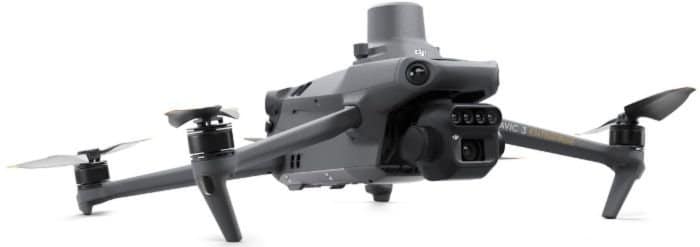 The DJI Mavic 3 Multispectral is DJI’s latest offering in the domain of drones with multispectral cameras. This state-of-the-art drone has been designed to be compact and easy to transport. Despite its small size, it comes packed with a multitude of powerful features that make it one of the best drones with multispectral cameras currently available on the market. Its advanced imaging system lies at the heart of the DJI Mavic 3 Multispectral drone.
The DJI Mavic 3 Multispectral is DJI’s latest offering in the domain of drones with multispectral cameras. This state-of-the-art drone has been designed to be compact and easy to transport. Despite its small size, it comes packed with a multitude of powerful features that make it one of the best drones with multispectral cameras currently available on the market. Its advanced imaging system lies at the heart of the DJI Mavic 3 Multispectral drone.
It houses a quartet of 5MP multispectral cameras that operate in the green, red, red edge and near-infrared wavelengths. Additionally, it is equipped with a high-resolution 20MP RGB camera that employs a 4/3 CMOS sensor. This potent combination of cameras opens up a world of possibilities, from precise aerial mapping to monitoring crop health and even conducting surveys of natural resources.
The RGB camera’s high-speed burst capability is a bonus, offering rapid image capture sequences. The integrated sunlight sensor is one distinguishing feature of this DJI drone with a multispectral camera. This innovative feature records solar irradiance data in image files, which aids in compensating for light changes during 2D data reconstruction. The outcome is more accurate NDVI readings and superior consistency in the gathered data over time, making it a vital tool for reliable agricultural and environmental data collection.
Incorporating an RTK module, the DJI Mavic 3 Multispectral drone is capable of achieving centimetre-level positioning. This feature facilitates high-accuracy aerial mapping without the need for ground control points. It’s a remarkable function, especially when precise geospatial data is essential, such as in comprehensive surveying or mapping tasks.
One of the impressive features of this DJI drone with a multispectral camera is its long flight time. The drone can stay airborne for up to 43 minutes and can map a whopping 200 hectares in a single flight. This performance efficiency reduces the time and effort required to survey vast areas.
The drone’s O3 transmission system ensures a stable signal and smooth image transmission, even at distances up to 15km. Coupled with omnidirectional obstacle sensing, the drone can securely navigate and capture high-quality data in diverse conditions. If you want a powerful yet compact drone with a multispectral camera, the DJI Mavic 3M is the best option.
2. eBee AG
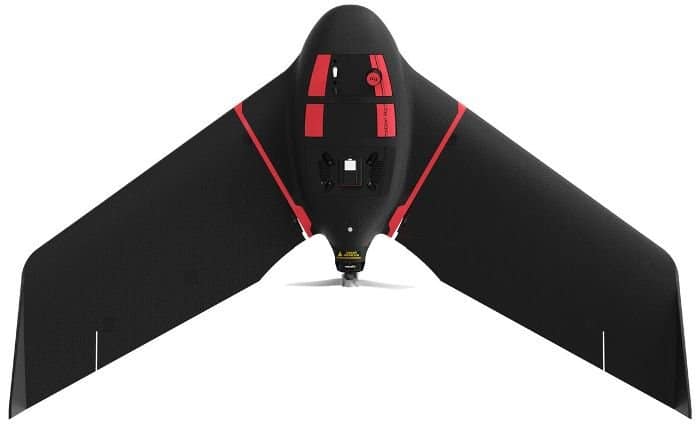
The eBee Ag is a precision agriculture drone designed by AgEagle Aerial Systems Inc. to provide user-friendly crop mapping and monitoring solutions. Built for farmers, agronomists, and agricultural service providers, it comes equipped with advanced aerial imaging capabilities that allow for comprehensive crop and field analysis. This aids users in making informed decisions concerning irrigation, fertilisation, and pest management.
One of the key features of the eBee Ag drone is the Duet M multispectral camera, which captures high-resolution RGB and multispectral images. The multispectral camera provides essential insights into plant health, stress levels, and vegetation indices by collecting data across multiple wavelengths, including visible and near-infrared bands.
The drone’s lightweight and durable airframe ensures efficient and extended flights, allowing it to autonomously navigate predefined flight paths and capture high-quality imagery with its integrated camera system. Furthermore, depending on various factors such as payload and weather conditions, the eBee Ag drone can offer flight durations of up to 55 minutes on a single battery charge, significantly enhancing its utility for agricultural data collection.
In the field of precision agriculture, the eBee Ag drone proves to be an invaluable asset by improving crop management and increasing agricultural productivity through its high-resolution multispectral camera and extended flight capabilities.
3. DJI Phantom 4 Multispectral
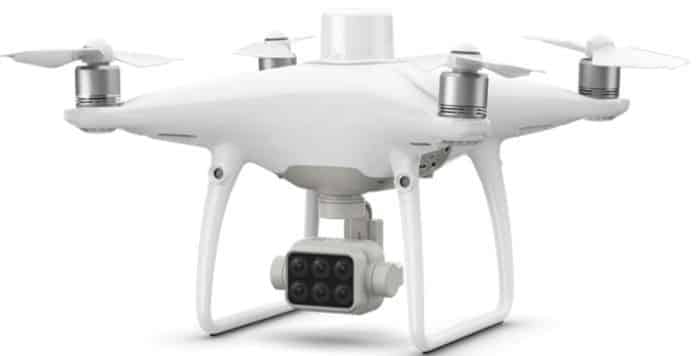 The DJI P4 Multispectral drone is part of the iconic Phantom 4 series and maintains the design aesthetics of these drones. It was the first DJI drone equipped with a multispectral camera system. This drone’s features include a robust integrated imaging system that offers stability and comprehensiveness.
The DJI P4 Multispectral drone is part of the iconic Phantom 4 series and maintains the design aesthetics of these drones. It was the first DJI drone equipped with a multispectral camera system. This drone’s features include a robust integrated imaging system that offers stability and comprehensiveness.
It’s equipped with an RGB camera and a multispectral camera array that includes five cameras, each designed to cover unique bands. This sophisticated imaging system ensures the collection of extensive and diverse data sets. Enhancing its precision, the P4 Multispectral drone showcases an impressive flight time of up to 27 minutes, and thanks to DJI’s OcuSync system, it can reach a transmission range extending up to 7 km.
These features allow for extensive area coverage and reliable data transmission, which is crucial for large-scale agricultural operations and environmental monitoring. One of the standout features of this drone is the incorporation of a spectral sunlight sensor, which measures solar irradiance. This inclusion elevates the accuracy and reliability of data capture throughout varying times of the day.
User experience with the drone is made versatile, with the ability to seamlessly switch between preliminary NDVI analysis and the live RGB feed. This enables real-time identification of areas necessitating attention and facilitates timely decision-making for targeted treatment applications.
Accuracy is further enhanced by the drone’s TimeSync system, which aligns the flight controller, cameras, and RTK module to provide centimetre-level measurements. Additionally, the P4 Multispectral drone is compatible with the D-RTK 2 Mobile Station, amplifying RTK positioning accuracy.
4. MicaSense RedEdge-P
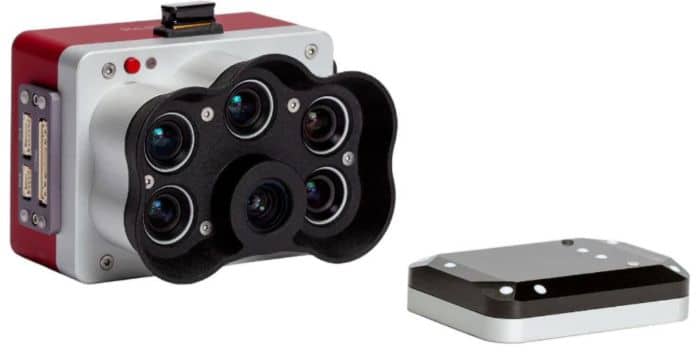 The MicaSense RedEdge Panchromatic (RE-P) is a high-end multispectral camera that combines a panchromatic sensor with five narrow bands to produce high-resolution multispectral and RGB imagery from a single flight. It offers a sharpened resolution down to 2 cm when flying at 60 m, making it twice as precise as the RedEdge-MX. The high resolution makes it suitable for applications requiring plant-level detail, such as plant counting and species identification, thereby proving valuable in fields like environmental monitoring and research.
The MicaSense RedEdge Panchromatic (RE-P) is a high-end multispectral camera that combines a panchromatic sensor with five narrow bands to produce high-resolution multispectral and RGB imagery from a single flight. It offers a sharpened resolution down to 2 cm when flying at 60 m, making it twice as precise as the RedEdge-MX. The high resolution makes it suitable for applications requiring plant-level detail, such as plant counting and species identification, thereby proving valuable in fields like environmental monitoring and research.
The MicaSense RedEdge-P showcases remarkable versatility, effortlessly integrating with a diverse selection of commercial drones across the market. 3 of which are listed below.
4. DJI Matrice 300 RTK With MicaSense RedEdge-P
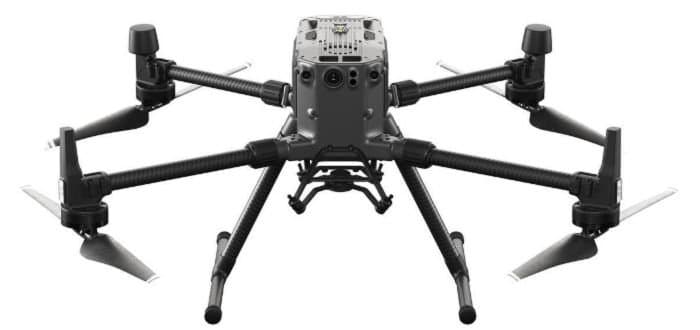 Revolutionising the realm of drone technology, the DJI Matrice 300 RTK is an aerial powerhouse packed with advanced AI capabilities. Engineered for various industrial applications, this drone’s standout features include an impressive flight time of up to 55 minutes, formidable wind resistance, and advanced sensors that ensure safe operation by detecting and avoiding obstacles in all directions. Its capacity to integrate multiple payloads allows for the use of a diverse range of sensors and cameras, making it a highly versatile device. The drone’s RTK (Real-Time Kinematic) system ensures that positioning data is accurate to the centimetre, promising precise data capture. It also includes an integrated health management system, offering real-time data on the drone’s critical systems for enhanced operational reliability.
Revolutionising the realm of drone technology, the DJI Matrice 300 RTK is an aerial powerhouse packed with advanced AI capabilities. Engineered for various industrial applications, this drone’s standout features include an impressive flight time of up to 55 minutes, formidable wind resistance, and advanced sensors that ensure safe operation by detecting and avoiding obstacles in all directions. Its capacity to integrate multiple payloads allows for the use of a diverse range of sensors and cameras, making it a highly versatile device. The drone’s RTK (Real-Time Kinematic) system ensures that positioning data is accurate to the centimetre, promising precise data capture. It also includes an integrated health management system, offering real-time data on the drone’s critical systems for enhanced operational reliability.
5. WingtraOne VTOL Drone
Melding the best of both worlds, the WingtraOne is a unique VTOL (Vertical Take-Off and Landing) drone, capable of taking off and landing like a multirotor drone while offering the extensive coverage capabilities of a fixed-wing drone. The WingtraOne excels in coverage, being able to scan large areas up to 310 ha in one flight. Its VTOL capabilities permit take-off and landing in tight areas, while its user-friendly interface facilitates a smooth operation. Built for durability, this drone can weather diverse operating conditions, providing a reliable solution for challenging applications.
6. eBee X Fixed-Wing Drone
The eBee X from AgEagle Aerial Systems Inc is a robust fixed-wing drone meticulously designed for mapping and surveying applications. Despite being lightweight, the eBee X doesn’t compromise on capabilities. It offers up to 90 minutes of flight time, enabling it to cover up to 500 ha in a single flight. Its modular design accommodates various payloads, allowing for customisation based on specific mission needs.
Paired with the proprietary eMotion flight planning software, the eBee X facilitates accurate and efficient data capture. Even though it’s feather-light, the eBee X is designed to endure challenging weather conditions, ensuring dependable performance. Its compatibility with the MicaSense RedEdge-P multispectral camera transforms the eBee X into a versatile instrument for a plethora of applications demanding advanced aerial imaging.
Final Thoughts
In conclusion, drones fitted with multispectral cameras are making a big difference in many areas. They’re helpful in sectors ranging from farming to environmental study, from exploring ancient sites to managing emergencies. They can capture detailed images in different wavelengths, which offers a new level of detail and efficiency for gathering data. We’ve dug deep into how these cameras work, looked at their wide range of uses and highlighted some of the best drones that work well with these cameras. Looking ahead, it’s clear that these drones and their multispectral cameras will only continue to improve and open up new opportunities in various fields.

